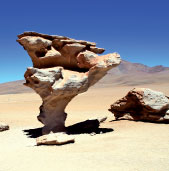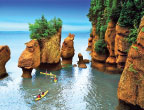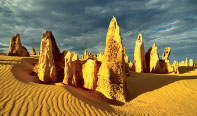 Golden Rock (Burma) Golden Rock (Burma)
Kyaiktiyo Pagoda, also known as Golden Rock, is a famous Buddhist
pilgrimage site in Mon State, Burma. A small pagoda (5.5 m - 18 ft) sits
on top of the “golden rock,” a granite boulder covered with gold leaves
pasted on by devotees. The rock itself is precariously perched and seems
to defy gravity as it perpetually appears to be on the verge of rolling
down the hill. |
 Delicate Arch (Utah, USA) Delicate Arch (Utah, USA)
A world famous arch located in Arches National Park (Utah, USA), the
Delicate Arch is a mysterious lone-standing arch that has become a
symbol of the state. |
 Stone Tree (Bolivia) Stone Tree (Bolivia)
A stone sculpted by wind and sand, the ‘Stone Tree’ is located high
on the Bolivian Altiplano, one of the world’s most beautiful landscapes.
|
 Mushroom Rock (Egypt) Mushroom Rock (Egypt)
This is one of the world’s most famous mushroom rocks, located in
Egypt. Also called ‘rock pedestals,’ they are one of the most striking
manifestations of the processes of erosion and weathering. Usually found
in desert areas, they are formed over thousands of years when erosion of
an isolated rocky outcrop progresses at a different rate at its bottom
than at its top. |
 Ayers Rock (Australia) Ayers Rock (Australia)
The large sandstone formation of Ayers Rock (also known as Uluru)
rises 1,142 feet from the desert. Its sheer size — with a circumference
of 6 miles — dwarfs everything around it. This iconic monolith of
Australia is one of the largest in the world. From dawn to dusk, it
takes on a stunning range of red to brown shades with the changing
light. Ayers Rock is sacred to the Aborigines of the area, who are known
as the Anangu. In recent years, Uluru has also become popular with New
Age practitioners. |
 Perce Rock (Canada) Perce Rock (Canada)
This rock formation is one of the largest natural arches in the
world. The pierced rock used to have two arches until one of the outer
arches collapsed in June 17, 1845. Despite the loss of one arch, the
Perce Rock is still tagged one of the valued seven wonders of Canada.
The rock gets its name from a large 15 metre (50 ft) high arch near its
seaward end. |
 Moon Valley (San Juan, Argentina) Moon Valley (San Juan, Argentina)
Situated in the province of La Rioja next to Talampaya National Park,
the Valley of the Moon is also a World Heritage site. It is located in
northeastern San Juan Province, Department of Valle Fértil, 120
kilometres north of the city of San Agustin. It gets its name due to its
rugged, otherworldly appearance. In the Carnian this area was a
volcanically active floodplain dominated by rivers and had a strongly
seasonal rainfall. |
 Melting Shadows (Utah, USA) Melting Shadows (Utah, USA)
Stone vertebrae snag morning’s light along the northern tip of Utah’s
Bridger Jack Mesa (foreground), leaving Lavender Canyon hidden in a
cold, purple shroud. Upper layers of the mesa are composed of what
geologists call Wingate sandstone, deposited about 200 million years ago
when sand dunes hundreds of feet thick carpeted the region. Weird and
wild rock formations abound on the 130,000-square-mile
(340,000-square-kilometre) Colorado Plateau, prompting one early settler
to describe it as “the roughest country you or anybody else ever seen;
it’s nothing in the world but rocks and holes, hills and hollows.”
|
 Split Apple Rock (New Zealand) Split Apple Rock (New Zealand)
The interesting formation of the famous Split Apple Rock on the South
Island of New Zealand looks exactly as the name suggests. Split Apple
Rock, situated near Marahau, Abel Tasman National Park, Tasman District,
is a very popular tourist destination. |
 Sphinx (Romania) Sphinx (Romania)
The Sphinx is megalith sculpted by wind in the Bucegi Mountains,
Romania. |
 Hopewell Rocks (Brunswick, Canada) Hopewell Rocks (Brunswick, Canada)
Hopewell Rocks are located in a popular tourist destination at
Hopewell Cape, New Brunswick, Canada. The bases of these breathtaking
sandstone formations have been worn away for thousands of years by the
Bay of Fundy’s powerful tidal waves. |
 The Pinnacles (Australia) The Pinnacles (Australia)
These beautiful limestone formations called The Pinnacles are
contained within Namburg National Park in Western Australia. The
Pinnacles were formed from lime leaching from the sand and by rain
cementing the lower levels of the dune into a soft limestone.
|

